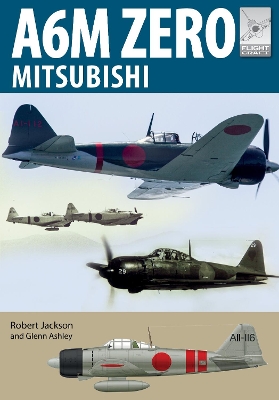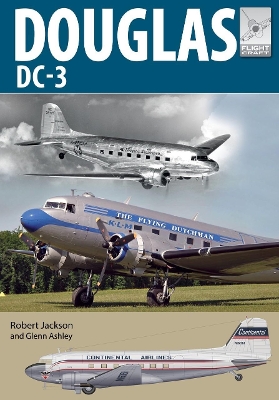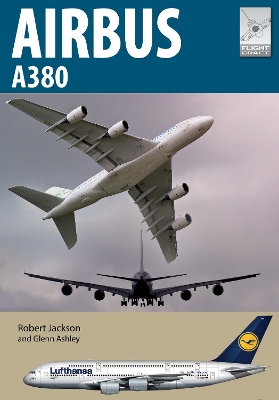Flight Craft
6 total works
The quality of Japanese aircraft came as an unpleasant surprise to the Allies at the outbreak of the Pacific War, and it was personified in one type, the Mitsubishi A6M Zero.
One of the finest aircraft of all time, the Mitsubishi A6M Reisen (Zero fighter) first flew on 1 April 1939\. It soon showed itself to be clearly superior to any fighter the Allies could put into the air in the early stages of the Pacific campaign. Armed with two 20mm cannon and two 7.7mm machine-guns, it was highly manoeuvrable and structurally very strong, despite being lightweight.
Instead of being built in several separate units, the Zero was revolutionary in that it was constructed in two pieces. The engine, cockpit and forward fuselage combined with the wings to form one rigid unit; the second part comprised the rear fuselage and the tail. The two units were joined by a ring of 80 bolts. Although the Mitsubishi Zero had some serious drawbacks in combat, the greatest of which was its inability to absorb punishment because of its lack of self-sealing fuel tanks and armour plating, its greatest assets were its manoeuvrability and its long range.
In 1942 the Americans allocated the code-name Zeke to the A6M, but as time went by the name Zero came into general use. During the first months of the Pacific War, the Zeros carved out an impressive combat record. For example, in the battle for Java alone, which ended on 8 March 1942, they destroyed 550 Allied aircraft. As the war progressed, however, the Zero gradually came to be outclassed by American fighters such as the Grumman F6F Wildcat and Vought Corsair. In the latter months, many were fitted with bombs and expended in Kamikaze suicide attacks.
This book provides a perfect introduction to the design and combat career of a fighter that made history. Why was the Zero conceived? What was it like to fly in combat? How did it compare with Allied types? Who were the engineers and designers who brought it to fruition and the pilots who became aces while flying it? Here is a feast for the modeller, with a wealth of technical information, photographs and colour profiles.
One of the finest aircraft of all time, the Mitsubishi A6M Reisen (Zero fighter) first flew on 1 April 1939\. It soon showed itself to be clearly superior to any fighter the Allies could put into the air in the early stages of the Pacific campaign. Armed with two 20mm cannon and two 7.7mm machine-guns, it was highly manoeuvrable and structurally very strong, despite being lightweight.
Instead of being built in several separate units, the Zero was revolutionary in that it was constructed in two pieces. The engine, cockpit and forward fuselage combined with the wings to form one rigid unit; the second part comprised the rear fuselage and the tail. The two units were joined by a ring of 80 bolts. Although the Mitsubishi Zero had some serious drawbacks in combat, the greatest of which was its inability to absorb punishment because of its lack of self-sealing fuel tanks and armour plating, its greatest assets were its manoeuvrability and its long range.
In 1942 the Americans allocated the code-name Zeke to the A6M, but as time went by the name Zero came into general use. During the first months of the Pacific War, the Zeros carved out an impressive combat record. For example, in the battle for Java alone, which ended on 8 March 1942, they destroyed 550 Allied aircraft. As the war progressed, however, the Zero gradually came to be outclassed by American fighters such as the Grumman F6F Wildcat and Vought Corsair. In the latter months, many were fitted with bombs and expended in Kamikaze suicide attacks.
This book provides a perfect introduction to the design and combat career of a fighter that made history. Why was the Zero conceived? What was it like to fly in combat? How did it compare with Allied types? Who were the engineers and designers who brought it to fruition and the pilots who became aces while flying it? Here is a feast for the modeller, with a wealth of technical information, photographs and colour profiles.
The North American P-51 Mustang was one of the most successful and effective fighter aircraft of all time. It was initially produced in response to a 1940 RAF requirement for a fast, heavily-armed fighter able to operate effectively at altitudes in excess of 20,000ft. North America built the prototype in 117 days, and the aircraft, designated NA-73X, flew on 26 October 1940. The first of 320 production Mustang Is for the RAF flew on 1 May 1941, powered by a 1,100hp Allison V-1710-39 engine. RAF test pilots soon found that with this powerplant the aircraft did not perform well at high altitude, but that its low-level performance was excellent.
It was when the Mustang airframe was married to a Packard-built Rolls-Royce Merlin engine that the aircraft's true excellence became apparent. Possessing a greater combat radius than any other Allied single-engine fighter, it became synonymous with the Allied victory in the air.
During the last eighteen months of the war in Europe, escorting bomber formations, it hounded the Luftwaffe to destruction in the very heart of Germany. In the Pacific, operating from advance bases, it ranged over the Japanese Home Islands, joining carrier-borne fighters such as the Grumman Hellcat to bring the Allies massive air superiority.
Yet the Mustang came about almost by accident, a product of the Royal Air Force's urgent need for new combat aircraft in the dark days of 1940, when Britain, fighting for survival, turned to the United States for help in the island nation's darkest hour.
It was when the Mustang airframe was married to a Packard-built Rolls-Royce Merlin engine that the aircraft's true excellence became apparent. Possessing a greater combat radius than any other Allied single-engine fighter, it became synonymous with the Allied victory in the air.
During the last eighteen months of the war in Europe, escorting bomber formations, it hounded the Luftwaffe to destruction in the very heart of Germany. In the Pacific, operating from advance bases, it ranged over the Japanese Home Islands, joining carrier-borne fighters such as the Grumman Hellcat to bring the Allies massive air superiority.
Yet the Mustang came about almost by accident, a product of the Royal Air Force's urgent need for new combat aircraft in the dark days of 1940, when Britain, fighting for survival, turned to the United States for help in the island nation's darkest hour.
No airliner in the history of commercial aviation has had a more profound effect than the Douglas DC-3\. It was reliable, easy to maintain and carried passengers in greater comfort than ever before.
Its origins stem from a design by the Douglas Aircraft Company of Santa Monica, California. Known as the Douglas Commercial One, or DC-1, this new aircraft was revolutionary in concept. It was quickly developed into the DC-2, an airliner that lead to Douglas' domination of the domestic air routes of the United States, and of half the world.
Experience with the DC-2 led to the development of an improved version, the Douglas Sleeper Transport (DST), first flown on 17 December 1935\. This in turn evolved into a 21-seat variant, the DC-3, featuring many improvements. The first American Airlines DC-3 entered service in June 1936, and within three years of its introduction the aircraft accounted for a staggering 95 percent of all commercial air traffic in the United States. From commencement of service to the Japanese attack on Pearl Harbor, the DC-3 increased domestic revenue passenger miles more than fivefold. Of the 322 aircraft operated by the country's airlines in December 1941, 260 were DC-3s. At the pre-war peak, 30 foreign airlines operated the DC-3\. On the eve of war, the DC-3's scheduled flights represented 90 percent of international air traffic.
In addition to over 600 civil examples of the DC-3, 10,048 military C-47 variants were built, as well as 4,937 produced under licence in the USSR as the Lisunov Li-2 and 487 built by Showa and Nakajima in Japan as the L2D. After the war, thousands of surplus C-47s, previously operated by several air forces, were converted for civilian use. These aircraft became the standard equipment of almost all the world's airlines, remaining in frontline service for many years. The ready availability of cheap, easily maintained ex-military C-47s, both large and fast by the standards of the day, jumpstarted the worldwide post-war air transport industry.
The full remarkable story of the DC-3, and its ancestor, the DC-2, is told in these pages, providing a wealth of information for the modeller and the enthusiast alike.
Its origins stem from a design by the Douglas Aircraft Company of Santa Monica, California. Known as the Douglas Commercial One, or DC-1, this new aircraft was revolutionary in concept. It was quickly developed into the DC-2, an airliner that lead to Douglas' domination of the domestic air routes of the United States, and of half the world.
Experience with the DC-2 led to the development of an improved version, the Douglas Sleeper Transport (DST), first flown on 17 December 1935\. This in turn evolved into a 21-seat variant, the DC-3, featuring many improvements. The first American Airlines DC-3 entered service in June 1936, and within three years of its introduction the aircraft accounted for a staggering 95 percent of all commercial air traffic in the United States. From commencement of service to the Japanese attack on Pearl Harbor, the DC-3 increased domestic revenue passenger miles more than fivefold. Of the 322 aircraft operated by the country's airlines in December 1941, 260 were DC-3s. At the pre-war peak, 30 foreign airlines operated the DC-3\. On the eve of war, the DC-3's scheduled flights represented 90 percent of international air traffic.
In addition to over 600 civil examples of the DC-3, 10,048 military C-47 variants were built, as well as 4,937 produced under licence in the USSR as the Lisunov Li-2 and 487 built by Showa and Nakajima in Japan as the L2D. After the war, thousands of surplus C-47s, previously operated by several air forces, were converted for civilian use. These aircraft became the standard equipment of almost all the world's airlines, remaining in frontline service for many years. The ready availability of cheap, easily maintained ex-military C-47s, both large and fast by the standards of the day, jumpstarted the worldwide post-war air transport industry.
The full remarkable story of the DC-3, and its ancestor, the DC-2, is told in these pages, providing a wealth of information for the modeller and the enthusiast alike.
On 27 April 2005, an aircraft lifted away from the runway of Toulouse-Blagnac Airport under the power of six massive Rolls-Royce Trent 900 turbofan engines. It carried a six-man crew, it was making its first flight, and it was making history. For this was the Airbus A380, the largest passenger aircraft in the world.
Airbus Industrie was a latecomer to the commercial airliner market, and initially struggled to win orders away from the well-established US giants, Boeing and McDonnell Douglas. Part of Airbus's strategy for success was to offer customers distinct families of aircraft that could be tailored to meet a wide range of performance and capacity demands. Before 2005, the largest and arguably most important members of this family strategy were the Airbus A330 and 340 high-capacity airliners; then along came the A380.
With air traffic continuing to double every 15 years, the A380 was designed to meet the needs of the passengers and airports, while also delivering the level of efficiency necessary to protect the environment for future generations. The design incorporated two full-length decks with wide-body dimensions, meaning its two passenger levels offered an entire deck's worth of additional space compared to the next largest twin-engine jetliner. With more seats than any other aircraft, the A380 offered solutions to overcrowding; needing fewer journeys to carry 60 percent more passengers, making it the perfect solution to airport congestion, fleet planning optimization and traffic growth. Typical seating capacity was 525, although the aircraft was certified to carry up to 853 passengers.
By mid-2019, fifteen airlines were operating 238 aircraft throughout the world, the original customer being Singapore Airlines, which launched its first A380 service in October 2007\. Production of the A380 peaked at 30 aircraft per year in 2012 and 2014\. Then, in February 2019, the biggest customer, Emirates, announced that it was to reduce its latest order by 39 aircraft in favour of two other Airbus Models, the A350 and A330neo, a version using the same engines as the Boeing 787 Dreamliner. For Airbus, it was the last act. The Company announced that production of the A380 would cease by 2021.
Airbus Industrie was a latecomer to the commercial airliner market, and initially struggled to win orders away from the well-established US giants, Boeing and McDonnell Douglas. Part of Airbus's strategy for success was to offer customers distinct families of aircraft that could be tailored to meet a wide range of performance and capacity demands. Before 2005, the largest and arguably most important members of this family strategy were the Airbus A330 and 340 high-capacity airliners; then along came the A380.
With air traffic continuing to double every 15 years, the A380 was designed to meet the needs of the passengers and airports, while also delivering the level of efficiency necessary to protect the environment for future generations. The design incorporated two full-length decks with wide-body dimensions, meaning its two passenger levels offered an entire deck's worth of additional space compared to the next largest twin-engine jetliner. With more seats than any other aircraft, the A380 offered solutions to overcrowding; needing fewer journeys to carry 60 percent more passengers, making it the perfect solution to airport congestion, fleet planning optimization and traffic growth. Typical seating capacity was 525, although the aircraft was certified to carry up to 853 passengers.
By mid-2019, fifteen airlines were operating 238 aircraft throughout the world, the original customer being Singapore Airlines, which launched its first A380 service in October 2007\. Production of the A380 peaked at 30 aircraft per year in 2012 and 2014\. Then, in February 2019, the biggest customer, Emirates, announced that it was to reduce its latest order by 39 aircraft in favour of two other Airbus Models, the A350 and A330neo, a version using the same engines as the Boeing 787 Dreamliner. For Airbus, it was the last act. The Company announced that production of the A380 would cease by 2021.




